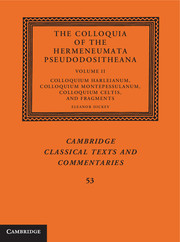Book contents
- Frontmatter
- Dedication
- Content
- List of plates page
- List of figures
- Acknowledgments
- Part One Colloquium Harleianum
- 1 Introduction to the Colloquium Harleianum
- TEXT, TRANSLATION, AND CRITICAL APPARATUS
- 2 Index Siglorum
- 3 Colloquium Harleianum
- Commentary
- 4 Commentary
- Part Two Colloquium Montepessulanum
- 5 Introduction to the Colloquium Montepessulanum
- Text, Translation, and Critical Apparatus
- 6 Index Siglorum
- 7 Colloquium Montepessulanum
- Commentary
- 8 Commentary
- Part Three Colloquium Celtis
- 9 Introduction to the Colloquium Celtis
- Text, Translation, and Critical Apparatus
- 10 Index Siglorum
- 11 Colloquium Celtis
- Commentary
- 12 Commentary
- Part Four Related texts
- 13 Editions of Papyri Connected to the Colloquium Tradition
- 14 The Berlin Trilingual Papyrus (P.Berol. INV. 10582): Reprinted Edition
- 15 Assorted Conversational Fragments(P.Berol. INV. 21860): New Edition
- 16 A Glossary Including Conversational Phrases (P.Lond. II.481): New Edition
- 17 A Glossary of Homonyms with Grammatical Information (P.Sorb. INV. 2069 Verso): Reprinted Edition
- 18 Grammatical Paradigms for Latin Learners (P.Louvre INV. E 7332): Reprinted Edition
- Endmatter
- References
- Indices to volumes I and II
- Index of notable Greek words and phrases
- Index of notable Latin words and phrases
- Index of topics mentioned in the colloquia
- Index of subjects discussed in the introduction and commentary
16 - A Glossary Including Conversational Phrases (P.Lond. II.481): New Edition
Published online by Cambridge University Press: 25 November 2020
- Frontmatter
- Dedication
- Content
- List of plates page
- List of figures
- Acknowledgments
- Part One Colloquium Harleianum
- 1 Introduction to the Colloquium Harleianum
- TEXT, TRANSLATION, AND CRITICAL APPARATUS
- 2 Index Siglorum
- 3 Colloquium Harleianum
- Commentary
- 4 Commentary
- Part Two Colloquium Montepessulanum
- 5 Introduction to the Colloquium Montepessulanum
- Text, Translation, and Critical Apparatus
- 6 Index Siglorum
- 7 Colloquium Montepessulanum
- Commentary
- 8 Commentary
- Part Three Colloquium Celtis
- 9 Introduction to the Colloquium Celtis
- Text, Translation, and Critical Apparatus
- 10 Index Siglorum
- 11 Colloquium Celtis
- Commentary
- 12 Commentary
- Part Four Related texts
- 13 Editions of Papyri Connected to the Colloquium Tradition
- 14 The Berlin Trilingual Papyrus (P.Berol. INV. 10582): Reprinted Edition
- 15 Assorted Conversational Fragments(P.Berol. INV. 21860): New Edition
- 16 A Glossary Including Conversational Phrases (P.Lond. II.481): New Edition
- 17 A Glossary of Homonyms with Grammatical Information (P.Sorb. INV. 2069 Verso): Reprinted Edition
- 18 Grammatical Paradigms for Latin Learners (P.Louvre INV. E 7332): Reprinted Edition
- Endmatter
- References
- Indices to volumes I and II
- Index of notable Greek words and phrases
- Index of notable Latin words and phrases
- Index of topics mentioned in the colloquia
- Index of subjects discussed in the introduction and commentary
Summary
This fourth-century papyrus fragment preserves portions of a Latin–Greek glossary, loosely organized by topic, containing three entries that consist of conversational phrases (lines 1, 36, and 37). These three phrases may be related to the colloquium tradition, though no specific connection to a particular colloquium can be made; in any case they demonstrate the extent to which colloquium-type phrases could circulate without a coherent context in bilingual materials. The Latin is transliterated into Greek script, so the intended audience was clearly one of Greek speakers.
The fragment is 19 cm high and 10 cm wide, but almost 4 cm on the right-hand side are fragmentary and have lost nearly all the ink on both sides. Enough traces remain there to show that another column of writing once existed on the recto, also in Greek script, but it is not possible to identify the language or make out any words; this column is therefore omitted from all editions of the papyrus, including the one below. The writing on the verso is upside down compared to that on the recto, so the papyrus does not come from a codex, but nevertheless recto and verso seem to contain the same text. This suggests that the original may have been a small piece of papyrus rather than a complete roll, for it is hard to imagine that this glossary was ever long enough to cover both sides of a whole roll: in the surviving fragment there are only a few entries on each topic and no identifiable headings or other aids that the reader would need to navigate a long glossary. The top of the recto (bottom of the verso) appears to preserve the original edge of the papyrus, and on the verso there is a bottom margin of 2.5 cm; on the recto there is a top margin of 0.5 cm. The left side of the fragment has a fairly neat edge and may well have been the original left side; if so there is a left-hand margin of 0.5–1 cm. If both these edges are in fact original the glossary has no title but simply begins with the entry on line 1, which runs across both the Latin and the Greek columns.
- Type
- Chapter
- Information
- The Colloquia of the Hermeneumata Pseudodositheana , pp. 284 - 287Publisher: Cambridge University PressPrint publication year: 2015



